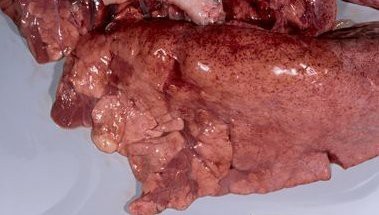M HYO
Overview
Swine enzootic pneumonia (SEP) is the most common respiratory disease in pigs. Caused by Mycoplasma hyopneumonia (M. hyo) it results in widespread and chronic disease. If not controlled, it can become endemic.
M. hyo is a tiny bacterium that lacks a cell wall. It is highly infectious. It is mainly spread via nose-to-nose contact between pigs. The organism can also be carried by people (in the nose) for up to 48 hours and has been shown to have the ability to spread up to 3 kilometers on the wind.
Farms that are free from M. hyo are highly vulnerable to infection from other M. hyo infected farms located in close proximity but also from pigs passing on lorries near to the farm.
M. hyo infection is often found in conjunction with other viral infections, especially PRRS (porcine reproductive and respiratory syndrome) and PCV2 infections and bacterial infections such as P. multocida, B. bronchiseptica, S. suis, H. parasuis, and A. pyogenes as part of the PRDC (porcine respiratory disease complex).
While signs of infection with M. hyo are not generally seen in pigs less than 6 weeks of age, any age of pig can become infected with this pathogen. Clinical signs of the disease tend to occur in pigs from two to six months of age.
The incubation period is dose-dependent. With high doses of the organism, the incubation period is 11 days, and four to six weeks for moderate doses. Low doses cause subclinical chronic infections.

Clinical Signs
The severity of the clinical signs and the degree of economic loss depend on the agents involved, the presence of secondary bacterial and/or viral infections, as well as environmental and management factors.
- In uncomplicated infections, clinical signs include mild chronic pneumonia with a non-productive cough, rough hair coat and reduced growth rate and feed efficiency
- With secondary bacterial and/or viral infections clinical signs are more severe and include increased coughing, laboured breathing, anorexia, fever and prostration
- In a herd, even moderately affected with M. hyo, growth rate can be reduced by over 100 grams per day
While clinical signs are typically found between two and six months of age, pigs of all ages are susceptible. Sows and gilts exposed to the disease for the first time can be severely affected resulting in serious fertility problems.
The most significant effect of M. hyo infection is to increase susceptibility to other pathogens that can cause severe respiratory problems in pigs.
Diagnosis
Confirmatory diagnosis can be achieved through a series of tests. Samples may be collected as follows:
- Nasal swabs
- Rope tests: carried out by hanging a rope among a group of pigs and allowing them to chew on the rope. After 15 to 30 minutes, the rope is removed. Oral fluids on the rope are squeezed into a sample bottle.
- Blood sampling
- Post mortem examination
Once samples are collected the agent may be detected using a variety of tests including:
- Culture on Mycoplasma selective media
- PCR (polymerase chain reaction) tests can be used to confirm infection. These tests are highly sensitive
- Evidence of infection may also be found through a blood test to detect antibodies to M. hyo
Furthermore, it must be borne in mind that piglets may have maternally derived antibodies until a certain age. A change in antibody levels from negative to positive in a number of pigs is likely to be diagnostic.

Treatment
Treatment of M. hyo is best carried out with antibiotics. Due to secondary bacterial infections that frequently occur, antibiotics may be required to treat the secondary infections. Timing of treatment with antibiotics should be considered; treating too early or too late is ineffective, so treatment over an extended period may be required usually via medicated feed.
Control
Control is dependent on good management to provide an optimal environment and attention to:
- Air quality
- Ventilation and temperature
- Stocking density
- Strict adherence to ‘all-in, all-out’ pig flow
- Washing and disinfection of accommodation between batches
- Removal of infected pigs from the main group and immediate treatment with hospitalisation in a separate air space
- Farm location and proximity to infected farms. This can also be a contributing factor when controlling M. hyo as the organism has been known to spread in the wind for up to 3 km
Immunisation by vaccination is highly effective in the control of M. hyo. Vaccination of piglets can be carried out from 7 days of age. Piglets are commonly given 2 doses of vaccine to suit certain management systems. When choosing M. hyo vaccine, the duration of immunity should be considered as pigs are slaughtered at heavier weights in recent years thus requiring a longer term of immunity.
